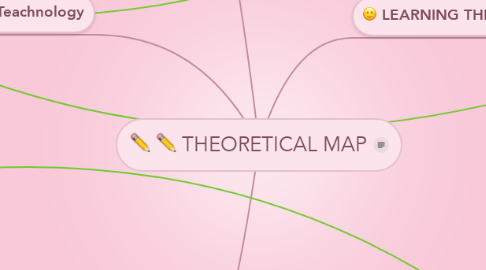
1. TECHNOLOGICAL THEORIES
1.1. Media Ecology
1.1.1. the study of media and the enviromenet
1.1.2. technological evolution or determinism
1.1.3. study of the turning of civilization based on the unprecidented leaps in technology
1.1.4. the interactions of communications media, technology, technique, and processes with human feeling, thought, value, and behavior—and they know, too, the kinds of questions about those interactions they are concerned to ask.
1.1.4.1. Media ecology looks into the matter of how media of communication affect human perception, understanding, feeling, and value; and how our interaction with media facilitates or impedes our chances of survival.
1.2. SCOT
1.2.1. Social Construction OF Technology
1.2.2. does society influence technology or does technology shape society
1.2.3. comes out of technological determinism
1.2.4. and! social contructivism
1.2.5. figure out why technologies are excepted and rejected in the social world
1.2.6. WHO defines technological sucess, and WHAT is the criteria for the 'best' based on?/
2. Personal Teachnology
2.1. promoting skills that will be sufficient for the progression of technology, not just for a single assingment or blog
2.1.1. students with varying levels of ability with technology use in the classroom , can help those less advanced, by forming a collaborative relation ship within every member of the class, more learning can be done. in a positive, influencial way.
2.2. motivate and excite students to push them to the brink of their current abilites
2.3. give students the endurance needed to analyze technological practices around them, being able to judge the benefits and costs and progress
2.4. awaken students to the realization that digital mediums are interrelated, so that forms of writting through digital mediums can be seen as 'proper' writting. this will show the parellel between academic writting and digital media writting.
2.5. pushing students in motivational and supportive ways is the way the classroom needs to function
2.6. SKILLS
2.6.1. giving students a set of skills for technology in the classroom. teaching them everything you know in an organized and understandable way. taking a fair amount of time for them to fully understand the processes that you are showing them, so actual learning can take place
3. TPACK(the inner combinations of ck pk and tk)
3.1. Technological Content knowledge
3.1.1. Technological content knowledge is knowledge about the manner in which Technology Knowledge (TK) and content knowledge (CK) are reciprocally related to each other.
3.2. Technological Pedagogical knowledge
3.2.1. Technological Pedagogical knowledge is knowledge of the existence, components and capabilities of various technologies as they are used in teaching and learning settings, and conversely, knowing how teaching might change as the result of using particular technologies
3.3. Pedagogical content knowledge
3.3.1. PCK is concerned with the representation and formulation of concepts, pedagogical techniques, knowledge of what makes concepts difficult or easy to learn, knowledge of students’ prior knowledge and theories of epistemology. It also involves knowledge of teaching strategies that incorporate appropriate conceptual representations, to address learner difficulties and misconceptions and foster meaningful understanding. It also includes knowledge of what the students bring to the learning situation, knowledge that might be either facilitative or dysfunctional for the particular learning task at hand.
4. LEARNING THEORIES
4.1. Connectivism
4.1.1. is said to be the learning theory for the digital age
4.1.2. has emotional influence, that is emotions are considered when studying learning
4.1.3. it is said that when PLNs are made, and netoworking happens, exponential learning can occur
4.1.4. non human sources of knowledge are increasingly important
4.1.5. persona skills and connections between people and their ideas are crucial
4.1.6. currency becomes the update of knowledge (knowledge is always changing)
4.1.7. decision making and the creation processes of learning are very important
4.2. Constructivism
4.2.1. the central idea is that learners build up knowledge from a foundation of PREVIOUSLY learned ideas
4.2.2. if students do not have original knowledge to create a base for new learning, they can not further themselves
4.2.3. accomodations happen when there are discrepencies or gaps in knowledge
4.2.4. learners assume responsibility for for maintaining and producing ideas, as in monitoring what goes in and out of the mind
4.2.5. collaboration is the key to gaining more knowlege,, just as in connectivism
4.3. Cognitive load
4.3.1. cognitive load, is how much the brain can hold, in which areas and for how long
4.3.2. theres is long term memory
4.3.3. short term memory
4.3.4. and working memory
4.3.5. the brain uses schemas and chunking to best hold information
4.3.6. everything that has ever been learned is in the brain, it is just what we use to retrieve and recall the information whcih allows our memeories to come through
4.3.7. cognitive dissonance happens when we are not able to form a schema to confirm a thought which is newley learned
4.3.8. there are 3 other sub catergories of load
4.3.9. 1. intrinsic load
4.3.9.1. the inherent difficulty of the information present
4.3.10. 2. extraneous load
4.3.10.1. artificial, unnessasry amount of loading in realtion to learning
4.3.11. 3.Germane load
4.3.11.1. artificial loading, from a 'teacher' which promotes the process of schemas, as not to overload the brain. chunk, or develope over time
